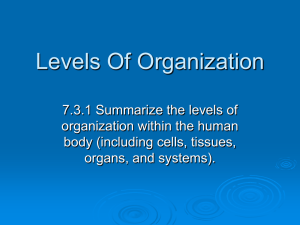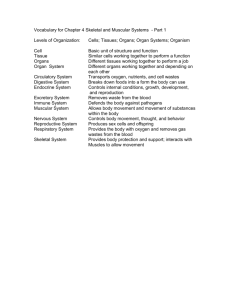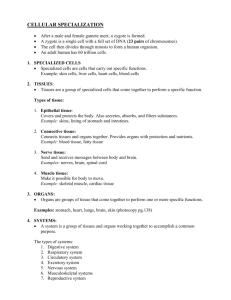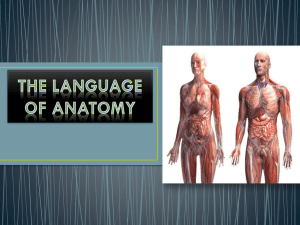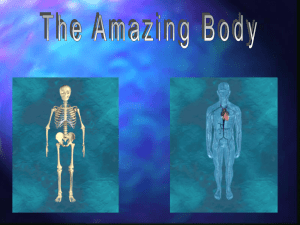Systems
advertisement
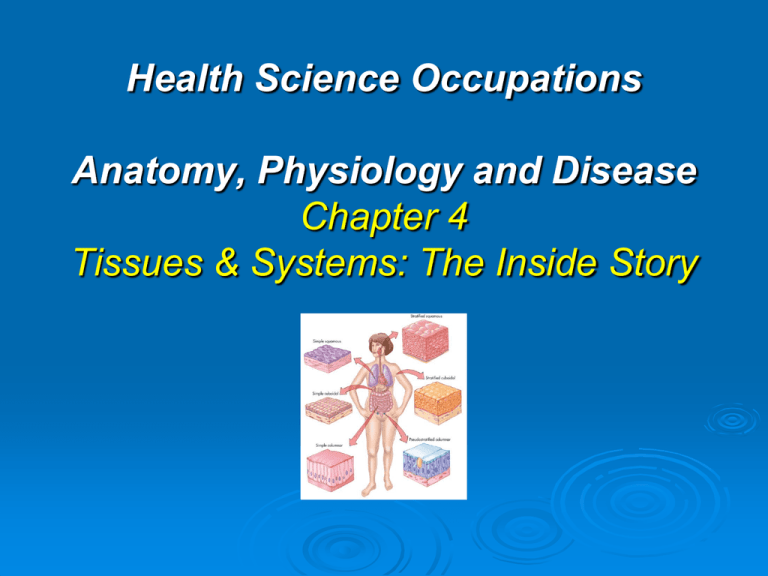
Health Science Occupations Anatomy, Physiology and Disease Chapter 4 Tissues & Systems: The Inside Story Introduction Cells are basic building blocks Similar cells are organized into tissues that perform similar functions. Organ: A collection of tissues designed to perform similar or several functions that work together to perform major specific activities & form systems. Ex: Kidneys, Heart, Lung, Brain Tissues Formed when there is collection of similar cells that act together to perform function Placed in a specific pattern to create functional walls, or tissues, of building Four main types: Epithelial Connective Muscle Nervous Epithelial Tissue Covers & lines much of body Cells are packed tightly together, forming a sheet that usually has no blood vessels in it Further classified by shape, as well as arrangement (morphological) Example: Flat or scale-like cells: squamous Cube shaped: cuboidal Column-like: columnar Epithelial Tissue cont’d Simple: When cells are arranged in single layer & are all same type of cell. Stratified: Are several layers deep, they are stratified & will be named by type of cell on outer layer. Pseudostratified: single layer of cells that looks stratified. Simple Stratified Pseudostratified Membranes Sheet-like structures found throughout body that perform special functions Epithelial membranes can be: Cutaneous: Skin which is 16% of body weight Serous: 2 layered membrane with space in between 1. Parietal- Lines walls of the cavity, produces serous fluid to reduce friction between different tissues & organs. 2. Visceral- wraps around organs & produces serous fluid Mucous: digestive, urinary, respiratory & reproductive tracts Membranes Connective Tissue Most common of tissues, and is found scattered throughout body Found in organs, bones, nerves, muscles, membranes, and skin Holds things together and provides structure and support Can form fine, delicate webs or strong cord-like structures similar to wire cables Synovial Membrane Membrane type associated with connective tissue Important membrane found in space between bone joints and produces slippery substance called Synovial fluid. This special fluid greatly reduces friction when joints move Muscle Tissue Provides means for movement This form of tissue has ability to shorten itself (contractility). Three types: Skeletal Cardiac Smooth Skeletal Muscle Called striated because of striped appearance Attached to bones; causes movement by contracting and relaxing Brain controls muscle contraction and relaxation; because these muscles are controlled consciously, they are called voluntary muscles Long, fiber-like cells with many nuclei in each cell Cardiac Muscle Found in walls of heart Heart beat uses involuntary muscle cells Cells within tissue interlock with each other; makes for more efficient contraction Smooth Muscles Forms walls of hollow organs such as in digestive system (often called visceral tissue) and blood vessels Are involuntary muscles Cells within tissue not as long and fibrous as skeletal muscles & each has only one nucleus Cardiac, Skeletal & Smooth Muscle Tissue Nervous Tissue Acts as rapid messenger service for body; messages can cause actions to occur; two types: Neurons: conduction of information • Dendrites: branch-like formations on neurons that receive sensory information • Axon: trunk-shaped structure that transports information away from cell body Glia (or neuroglia): support and connection cells Nervous Tissue Con’t Membranes that cover brain and spinal cord called meninges. Many nerves have insulating layer called Myelin Sheath. 2 Types of Nerve Cells Meningitis Inflammation of meninges (membranes that cover brain and spinal cord); caused by bacteria or virus Bacterial form can spread via droplets from sneezing or coughing; can also spread through contact with saliva of infected person; college students & military personnel in crowded situations at higher risk. Meningitis Cont’d Once infected, you become carrier of disease Only some people who become carriers will develop disease. In others, immune system actually destroys & removes pathogen before illness develops. Symptoms of Meningitis non-specific headaches fever nausea neck-stiffness skin rash hearing loss Neurologic/brain damage Renal (kidney) failure Mortality vs Morbidity Bacterial form has approximately 10% fatality rate. Vaccine available for prevention Does not protect against all pathogens that can cause meningitis. Has been associated with adverse reactions, including headaches, dizziness, vomiting, convulsions, & even death. Pathology Connection: Blood Sugar & Tissue Damage Diabetes (& high blood sugar) can cause damage to body tissues. Since glucose cannot be moved inside body cells, cells must burn fats & proteins in body for energy. As body uses up protein, tissues start to break down, becomes difficult to produce more tissue. Results in “Ketoacidosis.” With impaired tissue production, wounds become more difficult to heal, & infections become harder to fight. Blood Sugar & Tissue Damage (cont’d) Lipids released from fat so that cell can burn lipids for energy. Lipids can deposit around inside walls of blood vessels (atherosclerosis develops). Deposits cause impaired blood flow to tissues Together, tissue break down, deficient blood flow, & impaired wound healing mean that diabetics prone to tissue death & gangrene; can lead to loss of toes, feet, & even legs. Organs 2 or more types of tissues organizing in such a way as to accomplish something that tissues cannot do on their own. Some occur singularly; brain, thyroid, & some in pairs, kidneys, adrenal glands. Vital ones are those you can’t live without Others, like spleen, appendix, or gallbladder, can be removed without causing problems. Systems Formed by organs that work together to accomplish something more complex than what single organ can do on its own. Each is interrelated, often depending on each other for proper functioning of body. Skeletal System Functions Provides support & structure for body Protects organs Provides movement Stores variety of minerals Main components Bones Joints Ligaments Cartilage Muscular System Voluntary muscles Movement created by conscious thought Skeletal muscles attached to bones Involuntary muscles Perform without conscious thought Classified as smooth or cardiac muscle Found in blood vessels, airways, and organs Integumentary System Includes skin (body’s first line of protection) Regulates temperature through sweating, shivering, and changes in diameter of blood vessels in skin. Sensory information received from outside world (heat, cold, pain, pressure, etc.) comes from sensors in skin. Integumentary System Con’t Glands in skin help lubricate & waterproof skin, & inhibit growth of unwanted bacteria. Main components of system: skin, hair, sweat glands, sebaceous glands, & nails. Nervous System Sends and receives messages, stimulated by body’s internal & external environments. Conscious sensations occur as result of stimulation of our sensory receptors. Main parts of system: spinal cord, brain, peripheral nerves, nerve cells, and spinal fluid; special sensory organs: eyes, ears, nose, tongue, & skin. Three main functions: Sensory messages Processing & interpreting messages Sending messages Nervous System Endocrine System Acts as control center for virtually all of body’s organs. Endocrine glands release chemicals called hormones that are circulated via cardiovascular system, regulating metabolic processes & utilizing metabolites for growth and reproduction. Thyroxin Hypothyroidism Goiter Hyperthyroidism Endocrine System Cont’d Helps regulate fluid & electrolyte balance; helps cope with stresses produced by infection & trauma. Main components of system: hypothalamus, pineal, pituitary, thyroid, parathyroid, thymus, & adrenal glands, pancreas, & gonads, plus large variety of hormones. Endocrine System Cont’d Cardiovascular System Main transportation system to each cell of body Water, oxygen, and variety of nutrients & substances required for life transported to cells, while waste products removed from cells. Main components of system: heart, arteries, veins, capillaries, & blood. Pathology Connection: Septicemia Also called Sepsis or blood poisoning; condition in which pathogen is present in blood. Sepsis can lead to multi-system infection Blood can spread bacteria to organs Once bacteria get in organs, they adversely affect organ function. Septicemia Cont’d Signs and symptoms related to sepsis syndrome Fever Chills Tachypnea Tachycardia Skin lesions or rash (erythema) Hypoxemia Changes in mental status Hypotension Septicemia Cont’d Sepsis syndrome: infection causes decrease in blood perfusion to organs along with other systemic signs. Septic shock: decreased perfusion to organs causes critical drop in blood pressure. Septicemia Cont’d Multiple Organ Dysfunction Syndrome (MODS or multi-system failure) can develop if septic shock not quickly and effectively treated As number of involved organ systems increases, mortality rate rises; can approach 100% if continued for more than 4 hospital days, depending on patient. Respiratory System Supplies cells with oxygen and removes carbon dioxide. Filters, warms, and moistens air we breathe Mucous lining of airway helps trap foreign particles & pathogens. Respiratory System Con’t System also helps maintain proper acid-base balance. Main parts of system: nose, nasal cavity, trachea, larynx, pharynx, bronchial tubes, & lungs. Lymphatic System Responsible for helping to maintain proper fluid balance & protect us from infection. Special structures, called lymph nodes, act as filters to capture unwanted infectious agents. Lymphatic System Con’t Produces special white cells, called Tlymphocytes, to fight infection. Major parts of system: lymph vessels, lymph ducts, lymph nodes, thymus gland, tonsils, & spleen. Gastrointestinal (Digestive) System Breaks down nutrients mechanically & chemically into usable substances. Absorbs nutrients for transportation to cells Transports waste products out of body Main parts of system: mouth, pharynx, esophagus, stomach, sm & lg intestines, accessory organs, bowel, & anal canal. Pathology Connection: Body Image Obesity: Obesity is a medical condition in which excess body fat has accumulated to the extent that it may have an adverse effect on health, leading to reduced life expectancy and/or increased health problems. Pathology Connection: Anorexia Nervosa Condition in which there is progressive & severe weight loss. Avoid eating or eat too little food to sustain healthy weight. Pts deny problem Pathology Connection: Bulimia Pt has eating binges, overeats, then attempts to get rid of food by vomiting or using laxatives to avoid weight gain. Urinary System Important role in elimination of waste products, electrolytes, drugs, & other toxins, & excessive water. Functions: H2O regulation, BP regulation, regulation of RBCs, electrolyte balance, & pH balance. Main Parts: kidneys, ureters, urinary bladder, and urethra. Reproductive System Combined with urinary system to make genitourinary system. Purpose: to make new humans Main female parts: ovaries, uterus, fallopian tubes, eggs, & vagina Main male parts: testes, sperm, and penis

